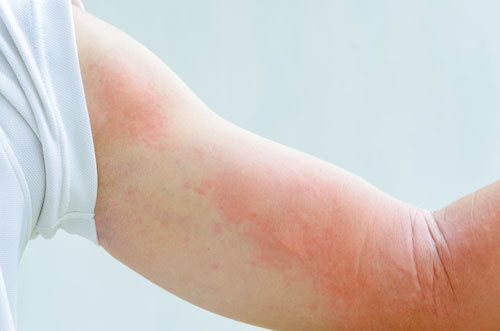Urticaria is an itchy rash or skin eruption, characterised by weals (hives), which may occur anywhere on the body, or angioedema (swelling of the deeper layers of the skin). It is usually temporary, disappearing within 24 to 48 hours.
Hives have many possible causes, including allergy.
Symptoms
- The rash has red weals (raised patches of skin) that often have skin-coloured centres. The weals may resemble mosquito bites.
- The rash is usually very itchy.
- Individual weals may come and go quite quickly — over hours.
- Weals may be a few millimetres in diameter or several centimetres.
- Weals may be round shaped or shaped like rings or maps.
- Weals may appear and fade repeatedly in chronic urticaria.
- Weals may appear in response to triggers, such as exercise, cold or stress.

Causes
There are many causes of urticaria, including:
- an allergic reaction to drugs, food or preservatives;
- fever;
- heat;
- cold;
- exercise;
- sweating (cholinergic urticaria);
- physical pressure; and
- infections, such as hepatitis or even a cold.
Dermographism is a physical urticaria where firm stroking of the skin produces a red line which swells and becomes surrounded by a red flush of the nearby skin. There can be a weal down the line of the stroke. Dermographism literally means ‘writing on the skin’.
Often the cause of urticaria is not identified.
Tests and diagnosis
Urticaria is classified according to its duration.
- Acute urticaria: Less than 6 weeks’ duration.
- Chronic urticaria: More than 6 weeks’ duration with regular episodes of weals.
Most people don’t need tests for their urticaria. If the urticaria is chronic and has been occurring for a long time, then tests to identify an allergic cause may be needed.
Complications
Complications of a hives episode may include:
- Breathing difficulties, if swelling occurs in the mouth or throat. If this happens dial 000 for an ambulance and get help immediately.
- Anaphylactic shock: a serious allergic reaction where you have difficulty breathing, your blood pressure drops and you may feel dizzy or faint. Dial 000 and seek help immediately.
Treatments for hives (urticaria)
There are several options for treating urticaria.
Avoiding known triggers
It’s important to try to avoid any known or suspected causes of urticaria. However, while it’s often possible to determine the cause of acute urticaria (which lasts hours, days or sometimes a few weeks), the cause of chronic urticaria (which lasts longer than 6 weeks, and may last for months or years) is often unknown.
Do not undertake a widespread exclusion diet unless a food trigger is confirmed. Elimination diets need to be carried out under supervision.
Salicylates, found not only in aspirin but also certain fruits and food additives such as tartrazine and benzoates are relatively common triggers. Aspirin can often make symptoms worse. If aspirin triggers your urticaria it’s important to see a doctor before using any medicines, including non-steroidal anti-inflammatory (NSAID) medicine.
Antihistamine medicines
Oral antihistamines (antihistamine medicines that you take by mouth) are usually the main treatment for urticaria. They can relieve the itch and control the rash in most people.
Non-sedating antihistamines are preferred, because they are effective, have few side effects and generally do not cause drowsiness. Sedating antihistamines (the types that make you drowsy) should be used only if the itching is severe and sedation would be useful, for example, at night. It is vital that you are aware of the sedating effects and the risk of driving or operating machinery while taking these medicines, as reaction times may be reduced significantly.
Sometimes, a combination of antihistamines works better than a single antihistamine on its own. If the urticaria does not respond to an antihistamine, see your doctor.
Anti-itch creams and lotions
Application of anti-pruritic (anti-itching) lotions and creams, such as calamine lotion, to the affected area of skin may provide relief of symptoms. Ask your doctor or pharmacist for advice.
Medicines used for severe urticaria
An antihistamine injection is sometimes required to treat extensive urticaria, or severe urticaria that involves the eyelids and lips.
Corticosteroid medicines are also sometimes used to treat more severe cases of urticaria. Oral corticosteroids can help lessen swelling, itching and redness.
Adrenaline/EpiPen. In cases of severe urticaria that is associated with anaphylaxis (a life-threatening allergic reaction), you may need an emergency injection of adrenaline. People who are prone to anaphylaxis need to carry an EpiPen (a device that can be used to give a shot of adrenaline in an emergency situation) with them at all times.
Self-help
The following self-help tips can help with hives.
- If you know what causes your urticaria, avoid it.
- A tepid shower or cool cloth may be soothing.
- Sitting next to a fan may be cooling and soothe the rash.
- Avoid getting close to heaters and avoid hot showers when you have hives.
- Avoid tight clothing as the pressure may worsen the weals and the itch.
When should you seek medical advice?
You should seek medical advice if urticaria:
- occurs in a child under 12 years old;
- lasts longer than 24 to 48 hours;
- occurs more often than just occasionally;
- covers a large area of your body;
- doesn’t respond to treatment; and if
- you also experience fever or general unwellness.
If there is marked swelling, especially if your face, eyes, lips or tongue are involved, or if there is any associated wheezing, seek medical advice urgently by calling 000 for an ambulance.
Related
ncG1vNJzZmilqZm%2Fb6%2FOpmWarV%2BouKq6jKGYoqpfqr%2B1tcKaqaKZXZ22t7HSaA%3D%3D